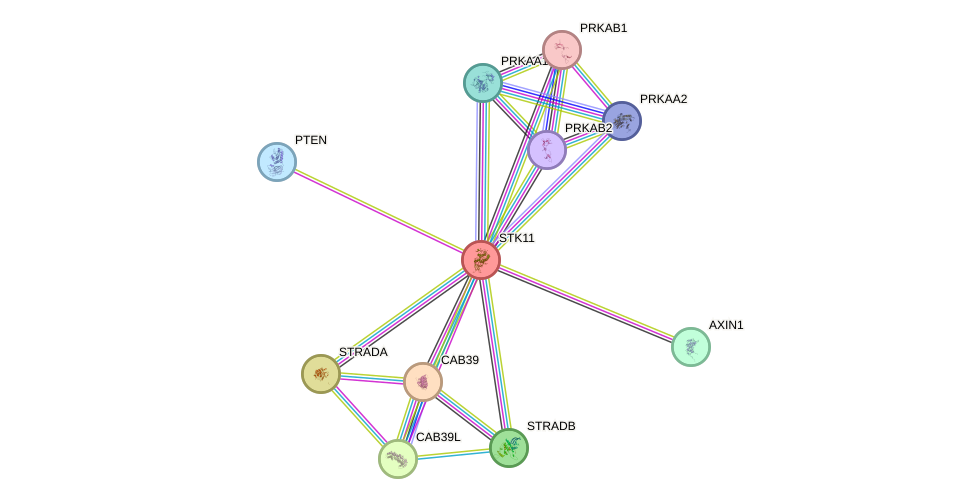GenAge entry for STK11 (Homo sapiens)
Gene name (HAGRID: 93)
- HGNC symbol
- STK11
- Aliases
- PJS; LKB1
- Common name
- serine/threonine kinase 11
Potential relevance to the human ageing process
- Main reason for selection
- Entry selected based on evidence linking the gene product to the regulation or control of genes previously linked to ageing
- Description
The exact functions of STK11 are unknown, but it appears to be involved in TP53-related apoptosis [509]. Evidence suggests it may play a role in development, and it is clear that STK11 is related to tumour development [971]. STK11 has not been directly linked to human ageing.
Cytogenetic information
- Cytogenetic band
- 19p13.3
- Location
- 1,205,799 bp to 1,228,435 bp
- Orientation
- Plus strand
Protein information
- Gene Ontology
-
Process: GO:0001558; regulation of cell growth
GO:0001894; tissue homeostasis
GO:0001944; vasculature development
GO:0006468; protein phosphorylation
GO:0006914; autophagy
GO:0006974; cellular response to DNA damage stimulus
GO:0007050; cell cycle arrest
GO:0007283; spermatogenesis
GO:0007399; nervous system development
GO:0007409; axonogenesis
GO:0008285; negative regulation of cell proliferation
GO:0010212; response to ionizing radiation
GO:0010508; positive regulation of autophagy
GO:0018105; peptidyl-serine phosphorylation
GO:0018107; peptidyl-threonine phosphorylation
GO:0030010; establishment of cell polarity
GO:0030111; regulation of Wnt signaling pathway
GO:0030154; cell differentiation
GO:0030308; negative regulation of cell growth
GO:0030511; positive regulation of transforming growth factor beta receptor signaling pathway
GO:0032147; activation of protein kinase activity
GO:0036399; TCR signalosome assembly
GO:0042593; glucose homeostasis
GO:0043276; anoikis
GO:0045059; positive thymic T cell selection
GO:0046777; protein autophosphorylation
GO:0048814; regulation of dendrite morphogenesis
GO:0050731; positive regulation of peptidyl-tyrosine phosphorylation
GO:0050772; positive regulation of axonogenesis
GO:0050852; T cell receptor signaling pathway
GO:0051055; negative regulation of lipid biosynthetic process
GO:0051645; Golgi localization
GO:0051896; regulation of protein kinase B signaling
GO:0060070; canonical Wnt signaling pathway
GO:0060770; negative regulation of epithelial cell proliferation involved in prostate gland development
GO:0071493; cellular response to UV-B
GO:0071902; positive regulation of protein serine/threonine kinase activity
GO:0072332; intrinsic apoptotic signaling pathway by p53 class mediator
GO:0097484; dendrite extension
GO:1900182; positive regulation of protein localization to nucleus
GO:1901796; regulation of signal transduction by p53 class mediator
GO:1904262; negative regulation of TORC1 signaling
Cellular component: GO:0005634; nucleus
GO:0005654; nucleoplasm
GO:0005737; cytoplasm
GO:0005739; mitochondrion
GO:0005829; cytosol
GO:0016020; membrane
GO:0036398; TCR signalosome
GO:0070062; extracellular exosome
Hide GO termsFunction: GO:0000287; magnesium ion binding
GO:0002039; p53 binding
GO:0004674; protein serine/threonine kinase activity
GO:0005515; protein binding
GO:0005524; ATP binding
GO:0030275; LRR domain binding
GO:0030295; protein kinase activator activity
Protein interactions and network
- Protein-protein interacting partners in GenAge
- TP53, HSP90AA1, GSK3B, APP, SIRT1, HSPA1A, H2AFX, TP63, STUB1
- STRING interaction network
Retrieve sequences for STK11
Homologs in model organisms
- Caenorhabditis elegans
- par-4
- Danio rerio
- stk11
- Drosophila melanogaster
- lkb1
- Mus musculus
- Stk11
- Rattus norvegicus
- Stk11

